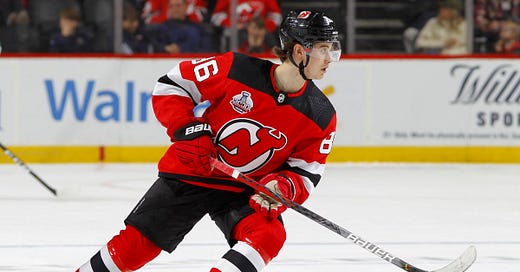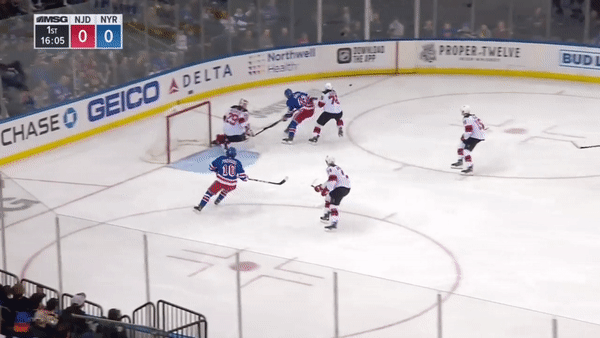Breaking Down Jack Hughes' Disappointing Rookie Season
A deep dive into what went wrong and what it means moving forward.
You know things are going wrong for a rookie when the Patrik Stefan comparables start to pop up. Devils centre Jack Hughes was the first top selection of the cap era to score fewer than 30 points as an 18-year-old, apparently validating the many scouts and analysts who argued that he was not physically ready to make the leap to the NHL. As much as the Devils organization and Hughes himself have tried to take this in stride, there’s no doubt that there will be plenty of pressure on him next season and plenty of people will be ready to call him a bust if he falters.
But how did his horrible rookie season come together? Was Hughes rushed into the NHL just because he was the top pick, forced into an almost unprecedented leap from the USHL to the show that he wasn’t ready for? Or do his counting stats not tell the full story here? What can we learn by digging into his underlying numbers, microstats, and game tape? In this piece, powered by macro-level analytics from EvolvingHockey, manually tracked stats from Corey Sznajder, and video, I’m going to do my best to answer these questions, explaining both Hughes’ results in every area of the game and what it means for him as a developing young player.
In my previous article, I dove into rival Kaapo Kakko’s abysmal first season with the Rangers. Hughes and Kakko had almost identical seasons on the score sheet; both finished on pace for 28 points and had matching +/- of -26. Each of them struggled to adapt to playing against NHL defencemen and had trouble fitting in with their linemates. But the way they got those results could not have been more different.
Profiling Jack Hughes Analytically
Jack Hughes’ results as measured by Evolving-Hockey’s Wins Above Replacement stat were below-replacement level this season - something that typically suggests that a player’s performance was not NHL-calibre. This was because his isolated impact on goals for (EV Off) and expected goals against (EV Def) was among the worst in the NHL. His finishing, measured by goals scored above expected, was among the absolute worst in the league, as were his goal scoring rates themselves. Simply put, Hughes did not do a lot to help his team win games this season. Moving from actual goals to expected goals, Hughes was above-average at driving scoring chances for his team when he was on the ice, but awful defensively. We’ll hit on that later on.
As for the counting stats, Hughes scored only nine primary points at 5v5, including two goals and seven primary assists. Four of his seven total goals came on the powerplay. His 5v5 point total was the second-lowest in a full season by an 18 year old since 2007-08 (out of 32 players) - Kaapo Kakko was the lowest.
Adding in the Eye Test
Jack Hughes is a dynamic player. Friend of the newsletter Brandon Holmes (@BHolmes_Hockey) compiled a highlight reel of Hughes that’s as fun to watch as it is aggregating - the most fitting way of summing up his season.
There are areas of the game where Hughes’ skillset translated very well to the NHL, and areas where it predictably did not. Whereas scouts were very wrong about Kakko’s NHL-readiness, I think they fairly assessed how Hughes’ lack of physical strength and the immensity of the difference between facing USHL defencemen and NHL defencemen would play out. With time and space available, namely in transition and on the powerplay, Hughes is electrifying and can take advantage of his world-class agility and skill with the puck. With a blueliner closing in, the outcome is more of a toss-up. In some cases, his instincts pay off and he can deliver a slick pass under pressure, but in others he panics and the play goes the other way. In this sense he’s similar to Kakko but for the opposite reason - Kakko gets beat by defenders despite his strength due to a lack of playmaking, while Hughes gets beat despite his playmaking due to a lack of strength.
It’s no secret that Hughes’ strength and balance is not NHL-level. Occasionally he can use his skating to navigate himself out of tricky situations but more often than not he’s easily rubbed out of the play. This has consequences at both ends of the ice and is something that he will have to address.
There are three big things that stand out to me about Hughes.
1. The Pucks Just Didn’t Go In
Like I said above, Hughes’ impact on on-ice goals for was horrific despite driving play pretty well. Looking at his individual and on-ice stats, it’s not difficult to see why:
At any stat involving pucks going into nets, Hughes was extremely unfortunate this season. According to Evolving-Hockey, Hughes accumulated 14.8 individual expected goals and scored only seven, while his linemates only scored nine out of 15. That should be no surprise to anybody who’s watched him. With credit to PuckDaily, I clipped some egregious examples of grade A chances he created that did not go in.
As I showed in a piece about how percentages work in hockey, even full-season on-ice percentages are extremely subject to randomness, and it is very unlikely that this continues into next season.
That being said, Hughes still deserves a good chunk of the heat for this. Remember how he ranked second-last in goals above expected? His finishing was actually even worse than that. One of the flaws of expected goals models is that public data cannot tell which shots come on breakaways. As you might remember from the highlight reel above, Hughes’ only two 5v5 goals this year came off of breakaways, and he missed a few of them as well. That means that many of his shots were underrated by the models, which would actually increase the gap between his expected goals and actual ones.
His shot needs a lot of work if he’s going to be able to beat goaltenders off in-zone possession instead of just scoring a handful of breakaways next season. Is he going to shoot 2.4% again next year? Probably not, but saying that it was just bad luck is giving him too much credit.
2. Lead the Rush.. and Then What?
Jack Hughes’ transition play was extraordinary this season. He finished 3rd in possession exits per 60 minutes and 12th in possession entries per 60 minutes, and dumped the puck in less frequently than anybody not named Connor McDavid or Nathan MacKinnon. The kid was confident carrying the puck to say the least.
If you watch Hughes play, the transition carries might be the first thing you notice. He dominates the neutral zone and navigates entries with ease. The issue is that a lot of these plays are one-and-done - they don’t actually really lead to anything. Take a late-season game against the Rangers, for example, in which he had six zone exits/entries in that game. In the short clip below, note what they ultimately amounted to:
Hughes has the confidence and the skill to carry the puck through the neutral zone, but his issues handling physicality and his lack of skilled linemates to defer to once in the zone make most of those plays dead on arrival. Opponents could take him out of the play or force a pass to a player like Wayne Simmonds or Pavel Zacha who lacked the puck skills to keep the play alive in a meaningful way. This is something that both he and the Devils will have to work on - he needs to connect the dots more effectively and the organization has to give him more offensively effective linemates.
Hughes is undoubtedly dangerous off the rush, but at 5v5 the Devils need him to be more effective in terms of puck possession plays. His shot assist rates were above average this year, but many of those were passes up to the point rather than dangerous plays to the slot. If Hughes can develop the ability to turn those zone entries into cycles more frequently it will dramatically improve his overall game.
3. Poor Defence
Another valid concern about Hughes is his poor defensive play. For a centre, he’s disengaged and tends to stay out of the tough areas for the most part, and he has a bad habit of drifting towards the blueline because he wants to get the rush going as much as possible. There were times when I had to double-check whether he was supposed to be playing centre or wing on a given shift, which isn’t a very good sign. Hughes is also prone to turnovers in the defensive zone, where forecheckers can limit how much time he has to make a decision (and can take advantage of his worst enemy, the boards). Take these two almost identical plays, which happened within ten seconds of one another:
Fundamentally, however, I got the impression that his biggest defensive issues were the product of poor possession. Like I said above, playing so frequently off the rush instead of spending time in the offensive zone will have consequences in your own end (ask Connor McDavid and Patrick Kane) and improving in that facet would likely have positive downstream effects.
Conclusion
Jack Hughes and Kaapo Kakko are intruiging counterparts for a number of reasons: they both had the worst D+1 rookie season by a player in their draft position, they play in the same division, and their issues were the almost direct inverse of eachother. Kakko’s strength, puck protection, and shot were expected to make him a dominant power forward right away, but tunnel vision, inability to be a complementary player, and linemates who couldn’t get him the puck in dangeous areas made that impossible. In Hughes’ case, superior puck skills and passing were often counteracted by a lack of physical strength, a weak shot, and linemates who couldn’t take advantages of chances they were given.
The Devils have time to be patient with Hughes and surround him with players who can support his strengths and capitalize on the opportunities he gives them. He shouldn’t be spending time with players like Zacha or Simmonds where he has to do all the work in the offensive zone, but should play with guys with puck skills like Nikita Gusev or Andreas Johnsson.
Devils fans should not be overly concerned about Hughes’ rookie season for two reasons. First of all, his counting stats were almost certainly extremely deflated by plain old bad puck luck, and even if he somehow didn’t improve his actual game at all next season he would almost certainly score more points. Secondly, the skills he needs to develop are some of the easiest things for a player to work on - he needs to be stronger, his shot needs to be a lot better, and he has to get used to playing against NHL defenders. The stuff that can’t be taught is the stuff Hughes can already do. It’s very important that he learn how to make the next play after entering the zone with the puck, and improving his ability to drive sustainable offensive zone possession rather than one-and-done rush attacks will have dividends at both ends of the ice. If he can put it together, Hughes has the talent to be one of the most electrifying players in this league.









Really good analysis. I don’t think I saw any Devils games, so interesting to see video along with stats.